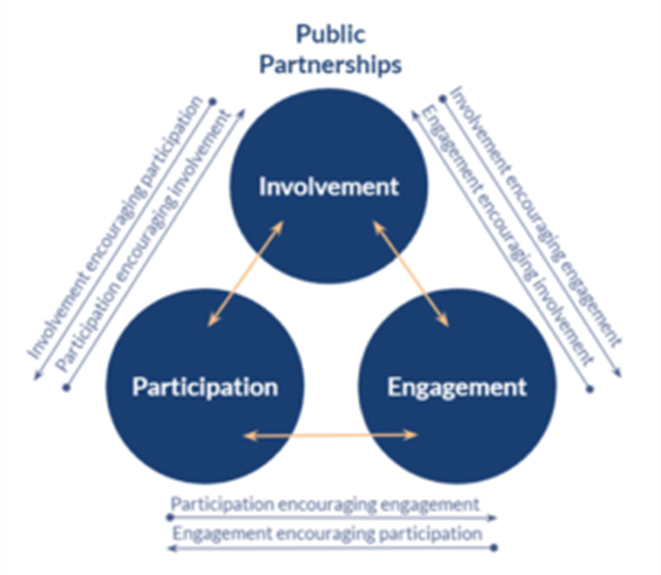PCIE can sometimes be referred to as PPI (Patient and Public Involvement) or PPIE (Patient and Public Involvement and Engagement). At the ARC KSS we think it’s important to see people as individuals, rather than as patients or service users. We also want to recognise the important role that communities play locally. This is reflected in our preferred term of 'PCIE', which stands for Public and Community Involvement and Engagement.
Both the terms ‘involvement’ and ‘engagement’, and others such as ‘participation’, are used to describe ways of interacting with the public and are sometimes used interchangeably. The ARC KSS PCIE Strategy uses these definitions:
- When using the term Public, we include patients, potential patients, carers and people who use health and social care services, people from organisations that represent people who use services, or members of the public with an interest in research. These public members are distinct from those who have a professional role in health or social care services.
Members of the public may be referred to as:
- Lay members
- Public Members
- Public Advisors
- Public Contributors
- Experts by Experience
- Lay advisors
- Patient partners
- Lived experience advisors
The label doesn’t really matter, it is hearing their voice in your research that is important.
- We use the term Community to define a social unit with commonality such as norms, religion, values, customs, situation or identity (e.g. gender, ethnicity, health condition). Communities may share a sense of place situated in a geographical area or in a virtual space through communication platforms.
- Involvement is defined as research carried out ‘with’ or ‘by’ members of the public rather than ‘to’, ‘about’ or ‘for’ them. Members of the public can be actively involved in research projects or in the research organisation itself. Examples of involvement in research are identifying research priorities, as members of a project advisory or steering group, commenting and developing patient information leaflets or other research materials.
- Engagement is providing the opportunity to share information and knowledge about research, to explore, debate and shape research. It is a two‐way process, involving interaction and listening, with the goal of generating mutual benefit (National Coordinating Centre for Public Engagement). Examples are researchers getting to know their communities, events where members of the public are invited to find out about research, raising awareness of research through social media, and news media.
- Participation is not defined in the strategy, but we use this to refer to people taking part in a research study, e.g. answering survey questions. However, if you work with community organisations, you may also hear the term 'Participation' used to describe involvement and engagement work.
More recently the NIHR encourages research to think more interchangeably about these seperate activties and how they all fit together and have come up with the all-emcompassing term public partnerships.

Public Partnerships is made up of three connecting areas: Involvement, Engagement and Participation. Involvement encourages engagement and engagement encourages involvement. Participation encourages engagement and engagement encourages participation. Involvement encourages participation and participation encourages involvement.
What about Co-Production...?
Co-production in research refers to a way of working where researchers, clinicians, practitioners, commissioners, community groups and members of the public (not an exhaustive list of potential partners) can work together as equal partners in a process that aims to identify a problem and share knowledge, share power and responsibility from start to end of the research. This is not a formal research method, more a set of principles that underpin a process. The principles include:
- Sharing of power and responsibility.
- Recognising everyone's skills and knowledge are of equal value.
- Including all perspectives, everyone has something to say.
- Learning from each other, we all benefit from working together.
Co-production is not simply ‘good PCIE’, nor is high quality PCIE co-production. However, they do share some common features, both are highly regarded and valued approaches to working with the public and communities.
Not all research or service development will be suited to using co-production, but all projects can benefit from some PCIE. There is always scope to involve members of the public so that their voices are heard. Two of our PhD students using co-production as a way of working in their projects wanted to share the lessons they learnt during this experience and have developed some 'top tips'.
Resources for Co-production
- Visit our Co-production Theme webpages.
- A Guide to Co-production for Researchers, Services and Commissioners.
- Guidance on co-producing a research project (NIHR 2024).
- Co-production of knowledge: the future, BMJ editorial as part of their co-production of knowledge collection.
- The Co-production Collective, a community of people interested in co-production where together they aim to learn, connect and champion co-production for lasting change.







